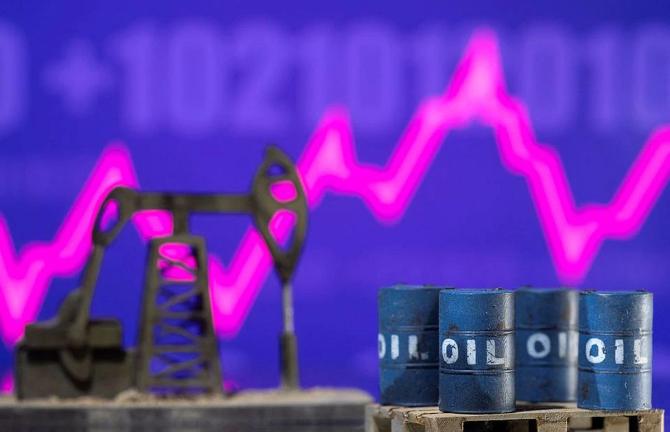The oil industry experienced three upheavals between 1973 and 1991, which seem to be etched in the memory of the industry’s decision makers.

Naturally, at the sign of a new crisis, the decision makers like to dip into those tumultuous decades to find ways to deal with the new shock, in addition, of course, to expert reports and forecasts.
So, the industry bigwigs turned the pages of history to get a peek into the future of oil price movements after Russia invaded Ukraine in 2022, Israel attacked Gaza in 2023, Iran-linked Houthi rebels pounded tankers crossing the Red Sea in support of Palestine the same year, and Iran rained missiles on Israel in 2024.
Except that the world has changed so much this century, with heightened environmental consciousness, renewable energy, and electric vehicles, that the old pages may have limited relevance.
That is evident, at least so far, in the fact that oil prices have not spiked as much as feared.
In fact, the peak the Indian crude oil basket touched since Russia invaded Ukraine in February 2022 was in June that year: $116.01 a barrel.
It has not crossed $100 a barrel after July 2022 and has stayed below $90 a barrel this year.
Crude oil has not vaulted above $100 because the market expects regional powers to show enough restraint to prevent a sharp escalation of the Israel-Iran conflicts that might jeopardize oil supply from West Asia, says Vandana Hari, a Singapore-based energy expert.
She adds that there is a protective risk premium in crude oil of around $12-15 a barrel, most of which will evaporate if Israel and Hamas strike a truce.
The movements of the Indian crude oil basket during the ongoing crises, and forecasts for oil prices are muted if you look at how oil moved during three major crises since 1971.
All those crises stemmed from West Asia and involved Israel and Iran, the two countries at the centre of the current crisis.
The reasons are diverse.
There is copious output by the United States, thanks to production from shale rock.
Chinese demand is subdued because of its slow economy and rise of electric vehicles in the country.
And discounted oil from sanctions-ridden Russia promises to temper the price increase for Indian refiners.
Chinese oil demand growth is set to decelerate as the year progresses — from 6.5 per cent year on year in the January-March quarter to just 1.3 per cent in the fourth quarter, US market intelligence agency Energy Intelligence says.
Demand for China’s main product, diesel, may have already peaked this year, and gasoline demand could follow suit and peak in 2025, says the agency, citing China’s largest refiner Sinopec and China National Petroleum.
Goldman Sachs’ base case is for Brent to stay below $100 a barrel, according to an April 7 note.
<p">The level could be breached if geopolitical impediments impact Opec’s ability to deploy spare capacity because of damages to oil infrastructure.
Opec, or the Organisation of the Petroleum Exporting Countries, controls petroleum production, supplies, and prices in the global market.
Years of shock
The First Oil Crisis started in October 1973, when war broke out in West Asia.
It prompted the Arab nations in Opec to implement production cuts and embargoes to resist Western backing for Israel.
The measures pushed crude oil prices from $2.7 a barrel to $13.
The Second Oil Crisis started with the coup in Iran in 1978, then the world’s fourth-largest crude supplier, and carried on with the outbreak of the Iran-Iraq war in 1980, causing oil prices to rise threefold to $40.3 a barrel in two years.
The 1990 Gulf War triggered the Third Oil Crisis, after Iraq invaded Kuwait. Prices rose by 70 per cent to $26.1 a barrel in 1991.
However, experts are cautioning against relying too much into those shocks, which occurred during the pre-internet age.
Oil behaves differently in the current era of information and climate change.
The needle on oil, relative to the surges witnessed during the past three oil crises, has budged much less.
There have been periods of volatility, but expectations of $150-$200 a barrel have not materialised, despite Opec and Russia slashing their outputs, reducing supplies to the world markets.
Oil prices rose by three to five times in the past when the Gulf nations were at war.
But European benchmark Brent has declined by around $3 a barrel after crossing $91 a barrel in early April.
Of course, analysts expect the prices to increase if hostilities escalated between Iran and Israel, or if Opec and Russia extended their production cuts, which are meant to end after June.
But nowhere is the increase comparable to the past crises.
Moreover, the Biden administration wants to keep a lid on oil prices in a US election year.
“An expanding conflict in West Asia is a cause for concern for crude oil and natural prices because about 20 million barrels per day of crude oil and condensate equivalent to about a fifth of the global consumption pass through the Strait of Hormuz, of which about 70 per cent comes to Asia,’’ says Prashant Vasisht, senior vice president and co-group head, corporate ratings, at Mumbai-based ratings agency ICRA.
ICRA, a US Moody’s affiliate, expects the average crude price for 2024-25 to be between $80 and $90 a barrel. Bhanu Patni, Associate Director, India Ratings & Research, expects oil to stay over $80 a barrel.
Risks baked in
US investment banks are somewhat sanguine about oil prices, but some forecasts for 2024 are still below this April peak.
Oil prices have about $5 to $10 a barrel of geopolitical risk currently baked in and without fresh developments or escalation in tensions, the path of least resistance for prices will likely be lower, Goldman Sachs’ head of oil research, Daan Struyven, told Bloomberg TV.
JP Morgan said last month that Russian output cuts of close to 500,000 barrels a day could push Brent oil prices to mid-$90 by May and close to $100 by September.
Morgan Stanley lifted its forecasts this month for Brent crude in the April-June quarter to $92 a barrel from $87.50, third quarter to $94 from $90, fourth quarter to $87.50, and first quarter and second quarters of 2024-25 at $82.50 a barrel, citing higher geopolitical risks impacting the market.
Indian scenario
The Indian crude oil basket witnessed a 23 per cent increase in prices from $94 barrel in February 2022, when Russia invaded Ukraine, to a peak of $116 in June after western sanctions cut in.
Prices slumped by 35 per cent in a year to $74.93 a barrel in June 2023, and averaged $89.57 a barrel this month, according to the oil ministry.
These prices do not account for rates of the discounted Russian oil.
“India still has a decent share of supply of Russian crude, which comprises 30 per cent of India’s total imports by end FY24, and it should help to keep India’s import bills for crude oil under check," says Hardik Shah, Director, CareEdge Ratings.
Another key reason for price stability despite Opec’s output cuts and the ongoing conflict is the record US output.
US crude oil exports in the first half of 2023 averaged 3.99 million barrels per day, a record high for the first half of a year since 2015, according to US government data — that is equivalent to 85 per cent of India’s current crude imports.
US elections are the key to where oil prices head, says R Ramachandran, former refinery director with Bharat Petroleum.
A Trump presidency means the US will keep producing oil.
Prices will remain range-bound if the current scenario persists, but if fighting escalates and Iraq is drawn into the conflict with Iran and Israel, Opec’s spare capacity may just be adequate to make up for the loss of capacity from the hostilities.
The flare up will also affect transport and insurance costs, as tankers are rerouted and war premiums get added, says Ramachandran.











